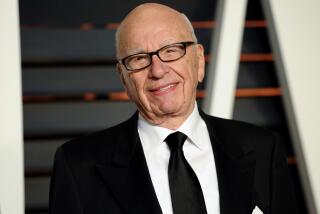Simmons Group Explains Challenge to Lockheed Board
- Share via
NEW YORK — A group seeking to take control of Lockheed Corp. by replacing the directors with its own nominees charged Sunday that the aerospace firm’s 1989 reorganization had been a “failure” and that its business strategy is “dangerously ambivalent.”
A proxy statement, designed to solicit the votes of Lockheed shareholders, was released by NL Industries, a Houston chemical company controlled by financier Harold C. Simmons. NL Industries, which supports the rival slate selected and led by Simmons, used the statement to explain its challenge to the Lockheed board and to present its own proposals for managing the company.
NL Industries also said it has no current plans to sell or liquidate important Lockheed assets and denied speculation that it plans to drain off “any over-funding” from Lockheed’s pension plans. Some Wall Street analysts have speculated that NL might want to return any excess to shareholders in the form of a special dividend.
Simmons’ company owns 18.9% of Lockheed’s stock. The proxy fight will be decided March 29 at Lockheed’s annual meeting when shareholders vote on the competing slates of directors.
Calling for the replacement of the present board, NL Industries’ statement said the Lockheed restructuring plan--put into effect last April--had failed to make the aerospace firm more competitive.
The statement referred to a slide in the value of the company’s stock and said it was associated with an earnings decline at Lockheed. The stock price, which reached a 12-month high of $54.75 in the third quarter of 1989, closed at $35.625 Friday. The company posted earnings of $2 million on sales of $9.9 billion in 1989, compared to a profit of $624 million on sales of $10.4 billion the year before.
Major causes of the earnings decline were losses in 1989 of more than $400 million on the P-7A Navy patrol aircraft program and on Lockheed’s production of the wings for the C-17 military transport plane for which McDonnell Douglas is the prime contractor.
Lockheed has attributed both losses to “industrywide” woes relating to fixed-price development contracts with the government--pacts that do not allow contractors to recoup losses from cost overruns. The P-7A and C-17 are both fixed-price projects.
Lockheed officials had no immediate comment Sunday on the proxy statement, but they had earlier cited their April, 1989, restructuring program as a strategy for improving earnings. Lockheed Chairman Daniel M. Tellep said in a recent letter to shareholders that the cornerstone of the restructuring is increasing the efficiency of the company’s core defense and aeronautics business.
Under the program, Tellep has said, he expects to cope with cuts in defense spending by generating more revenue in commercial operations, thereby reducing the company’s reliance on defense-related spending. Lockheed now obtains 75% of its revenues from Defense Department contracts.
However, NL Industries President J. Landis Martin said Sunday that the diversification effort diverts the attention of Lockheed executives from their “core” businesses of contracting for the Department of Defense and the National Aeronautics and Space Administration.
“We don’t think they’re imposing enough control over the core--particularly on the aeronautical division,” Martin said in a telephone interview after the proxy statement was released.
The proxy statement also weighed in on Lockheed’s diversification plan, calling it “dangerously ambivalent.”
NL Industries “believes that now, more than ever, Lockheed must focus on improving quality, lowering costs and enhancing confidence in its core space, missiles and aeronautical businesses,” the statement said.
Martin, in the interview, was particularly critical of Lockheed’s operations in computer graphics and commercial airplane modification and repair, calling them financial “under-performers.”
“There are too many companies in that (computer graphics) business, and many companies have been there for a long time,” he said. “It’s too competitive already.”
Martin said that if NL’s slate wins control of Lockheed on March 29, it will first try to improve Lockheed’s operations outside the defense and aeronautics fields. He added, however, that if a turnaround could not be achieved, the operations could be sold.
More to Read
Inside the business of entertainment
The Wide Shot brings you news, analysis and insights on everything from streaming wars to production — and what it all means for the future.
You may occasionally receive promotional content from the Los Angeles Times.










